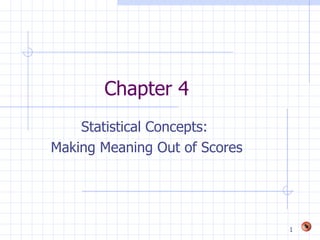Chapter 4
- 1. Chapter 4 Statistical Concepts: Making Meaning Out of Scores
- 2. Raw Scores Jeremiah scores a 47 on one test and Elise scores a 95 on a different test. Who did better? Depends on: How many items there are on the tests (47 or 950?) Average score of everyone who took the tests. Is higher or lower a better score?
- 3. Rule #1: Raw Scores are Meaningless ! Raw scores tell us little, if anything, about how an individual did on a test Must take those raw scores and do something to make meaning of them
- 4. Making Raw Scores Meaningful: Norm Group Comparisons However, norm group comparisons are helpful: They tell us the relative position, within the norm group, of a personâs score They allow us to compare the results among test-takers who took the same They allow us to compare test results on two or more different tests taken by the same individual
- 5. Frequency Distributions Using a frequency distribution helps to make sense out of a set of scores A frequency distribution orders a set of scores from high to low and lists the corresponding frequency of each score See Table 4.1, p. 69
- 6. Frequency Distributions (contâd) Make a frequency distribution: 1 2 4 6 12 16 14 4 7 21 4 3 11 4 10 12 7 9 3 2 1 3 6 1 3 6 5 10 3
- 7. Histograms and Frequency Polygons Use a graph to make sense out your frequency distribution Two types of graphs: Histograms (bar graph) Frequency Polygons Must determine class intervals to draw a histogram or frequency polygon Class intervals tell you how many people scored within a grouping of scores
- 8. Class Intervals Making Class Intervals (Numbers from Table 4.1, p. 69) Subtract lowest number in series of scores from highest number: 66 - 32 = 34 Divide number by number of class intervals you want (e.g., 7). 34/7 = 4.86 Round off number obtained: 4.86 becomes 5 Starting with lowest number, use number obtained (e.g., 5) for number of scores in each interval: 32â36, 37â41,42â46, 47â51, 52â56, 57â61, 62â66 See Table 4.2, p. 70; then Fig 4.1 and 4.2, p. 71
- 9. Creating Class Intervals Make a distribution that has class intervals of 3 from the same set of scores: 1 2 4 6 12 16 14 4 7 21 4 3 11 4 10 12 7 9 3 2 1 3 6 1 3 6 5 10 3
- 10. Making a Frequency Polygon and a Histogram From your frequency distribution of class intervals (done on last slide), place each interval on a graph. Then, make a frequency polygon and then a histogram using your answers.
- 11. Another Frequency Distribution Make a frequency distribution from the following scores: 15, 18, 25, 34, 42, 17, 19, 20, 15, 33, 32, 28, 15, 19, 30, 20, 24, 31, 16, 25, 26
- 12. Make a Class Interval Make a distribution that has class Intervals of 4 from the same set of scores: 15, 18, 25, 34, 42, 17, 19, 20, 15, 33, 32, 28, 15, 19, 30, 20, 24, 31, 16, 25, 26
- 13. Create A Frequency Polygon and Histogram From your frequency distribution of class intervals (done on last slide), place each interval on a graph Then, make a frequency polygon and then a histogram using your answers
- 14. Cumulative Distributions Also called Ogive curve Gives information about the percentile rank Convert frequency of each class interval into a percentage and add it to previous cumulative percentage (see Table 4.3, p. 72) Graph class intervals with their cumulative percentages (see Figure 4.3, p. 73) Helps to determine percentage on any point in the distribution
- 15. Normal and Skewed Curves The Normal Curve Follows Natural Laws of the Universe Quincunx (see Fig. 4.4, p. 73): www.stattucino.com/berrie/dsl/Galton.html Rule Number 2: God does not play dice with the universe.â (Einstein) Contrast with Skewed Curves (See Fig. 4.5, p. 74)
- 16. Measures of Central Tendency Helps to put more meaning to scores Tells you something about the âcenterâ of a series of scores Mean, Median, Mode Compare means, medians, and modes on skewed and normal curves (see page 76, Figure 4.6)
- 17. Measures of Central Tendency Median: Middle Score odd number of scoresâexact middle even number: average of two middle scores. Mode: Most frequent score Median: Add scores and divide by number of scores See Table 4.4, p. 75
- 18. Measures of Variability Tells you even more about a series of scores Three types: Range: Highest score - Lowest score +1 Standard Deviation Interquartile Range
- 19. Interquartile Range (middle 50% of scores--around median) see Figure 4.7, p. 77 Using numbers from previous example: (3/4)N - (1/4)N (where N = number of scores) 2 then, round off and find that specific score See Table 4.5, p. 78
- 20. Standard Deviation Can apply S.D. to the normal curve (see Fig. 4.9, p. 80) Many human traits approximate the normal curve Finding Standard Deviation (see Table 4.6, p. 80) Find another SD (next two slides)
- 21. Figuring Out SD X X - M (X - M) 2 12 12-8 4 2 = 16 11 11-8 3 2 = 9 10 10-8 2 2 = 4 10 10-8 2 2 = 4 10 10-8 2 2 = 4 8 8-8 0 2 = 0 7 7-8 1 2 = 1 5 5-8 3 2 = 9 4 4-8 4 2 = 16 3 3-8 5 2 = 25 80 88
- 22. Figuring Out SD (Contâd) SD = 88/10 = ï 8.8 = 2.96
- 23. Remembering the Person Understanding measures of central tendency and variability helps us understand where a person falls relative to his or her peer group, butâĶ. Donât forget, that how a person FEELS about where he or she falls in his or her peer group is always critical






















